Marketing Essentials Report: Role of Marketing and Marketing Mix
VerifiedAdded on 2021/10/06
|48
|13714
|120
Report
AI Summary
This report, submitted by a student, analyzes marketing essentials within an organizational context. Part 1 explores the fundamental concepts of marketing, including needs, wants, demands, and the five marketing concepts (production, product, selling, and marketing). It outlines the roles and responsibilities of marketing managers and examines the interrelationships between marketing and other functional units. Part 2 delves into the 7Ps of the marketing mix and showcases its application through comparative analysis of two organizations. The report culminates in the creation of a comprehensive marketing plan, incorporating an action plan and methods for monitoring and evaluating progress. The assignment demonstrates a clear understanding of marketing principles and their practical application in a business setting, providing a detailed overview of marketing strategies and their impact on business objectives.
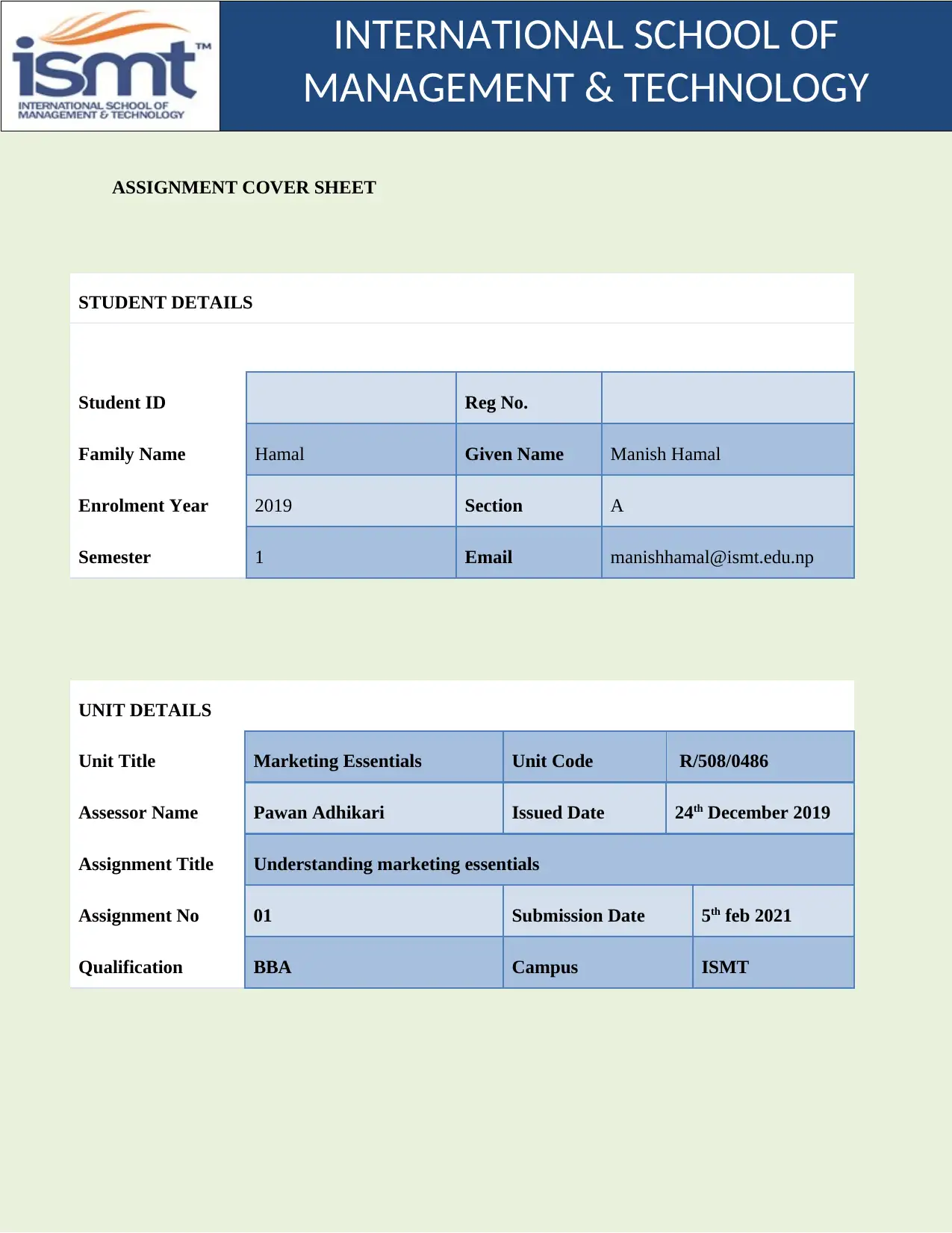
INTERNATIONAL SCHOOL OF
MANAGEMENT & TECHNOLOGY
ASSIGNMENT COVER SHEET
STUDENT DETAILS
Student ID Reg No.
Family Name Hamal Given Name Manish Hamal
Enrolment Year 2019 Section A
Semester 1 Email manishhamal@ismt.edu.np
UNIT DETAILS
Unit Title Marketing Essentials Unit Code R/508/0486
Assessor Name Pawan Adhikari Issued Date 24th December 2019
Assignment Title Understanding marketing essentials
Assignment No 01 Submission Date 5th feb 2021
Qualification BBA Campus ISMT
MANAGEMENT & TECHNOLOGY
ASSIGNMENT COVER SHEET
STUDENT DETAILS
Student ID Reg No.
Family Name Hamal Given Name Manish Hamal
Enrolment Year 2019 Section A
Semester 1 Email manishhamal@ismt.edu.np
UNIT DETAILS
Unit Title Marketing Essentials Unit Code R/508/0486
Assessor Name Pawan Adhikari Issued Date 24th December 2019
Assignment Title Understanding marketing essentials
Assignment No 01 Submission Date 5th feb 2021
Qualification BBA Campus ISMT
Paraphrase This Document
Need a fresh take? Get an instant paraphrase of this document with our AI Paraphraser
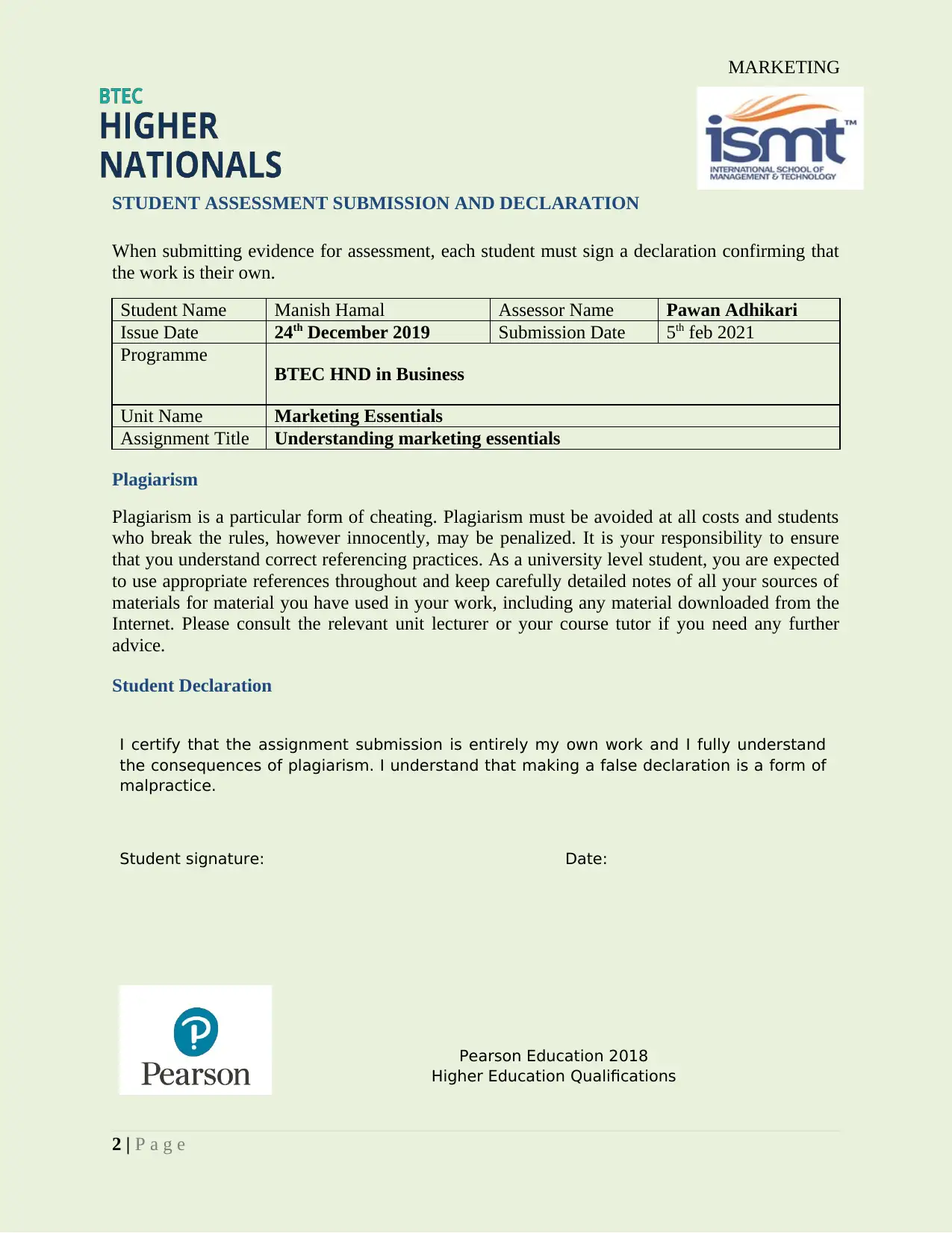
MARKETING
STUDENT ASSESSMENT SUBMISSION AND DECLARATION
When submitting evidence for assessment, each student must sign a declaration confirming that
the work is their own.
Student Name Manish Hamal Assessor Name Pawan Adhikari
Issue Date 24th December 2019 Submission Date 5th feb 2021
Programme
BTEC HND in Business
Unit Name Marketing Essentials
Assignment Title Understanding marketing essentials
Plagiarism
Plagiarism is a particular form of cheating. Plagiarism must be avoided at all costs and students
who break the rules, however innocently, may be penalized. It is your responsibility to ensure
that you understand correct referencing practices. As a university level student, you are expected
to use appropriate references throughout and keep carefully detailed notes of all your sources of
materials for material you have used in your work, including any material downloaded from the
Internet. Please consult the relevant unit lecturer or your course tutor if you need any further
advice.
Student Declaration
2 | P a g e
I certify that the assignment submission is entirely my own work and I fully understand
the consequences of plagiarism. I understand that making a false declaration is a form of
malpractice.
Student signature: Date:
Pearson Education 2018
Higher Education Qualifications
STUDENT ASSESSMENT SUBMISSION AND DECLARATION
When submitting evidence for assessment, each student must sign a declaration confirming that
the work is their own.
Student Name Manish Hamal Assessor Name Pawan Adhikari
Issue Date 24th December 2019 Submission Date 5th feb 2021
Programme
BTEC HND in Business
Unit Name Marketing Essentials
Assignment Title Understanding marketing essentials
Plagiarism
Plagiarism is a particular form of cheating. Plagiarism must be avoided at all costs and students
who break the rules, however innocently, may be penalized. It is your responsibility to ensure
that you understand correct referencing practices. As a university level student, you are expected
to use appropriate references throughout and keep carefully detailed notes of all your sources of
materials for material you have used in your work, including any material downloaded from the
Internet. Please consult the relevant unit lecturer or your course tutor if you need any further
advice.
Student Declaration
2 | P a g e
I certify that the assignment submission is entirely my own work and I fully understand
the consequences of plagiarism. I understand that making a false declaration is a form of
malpractice.
Student signature: Date:
Pearson Education 2018
Higher Education Qualifications
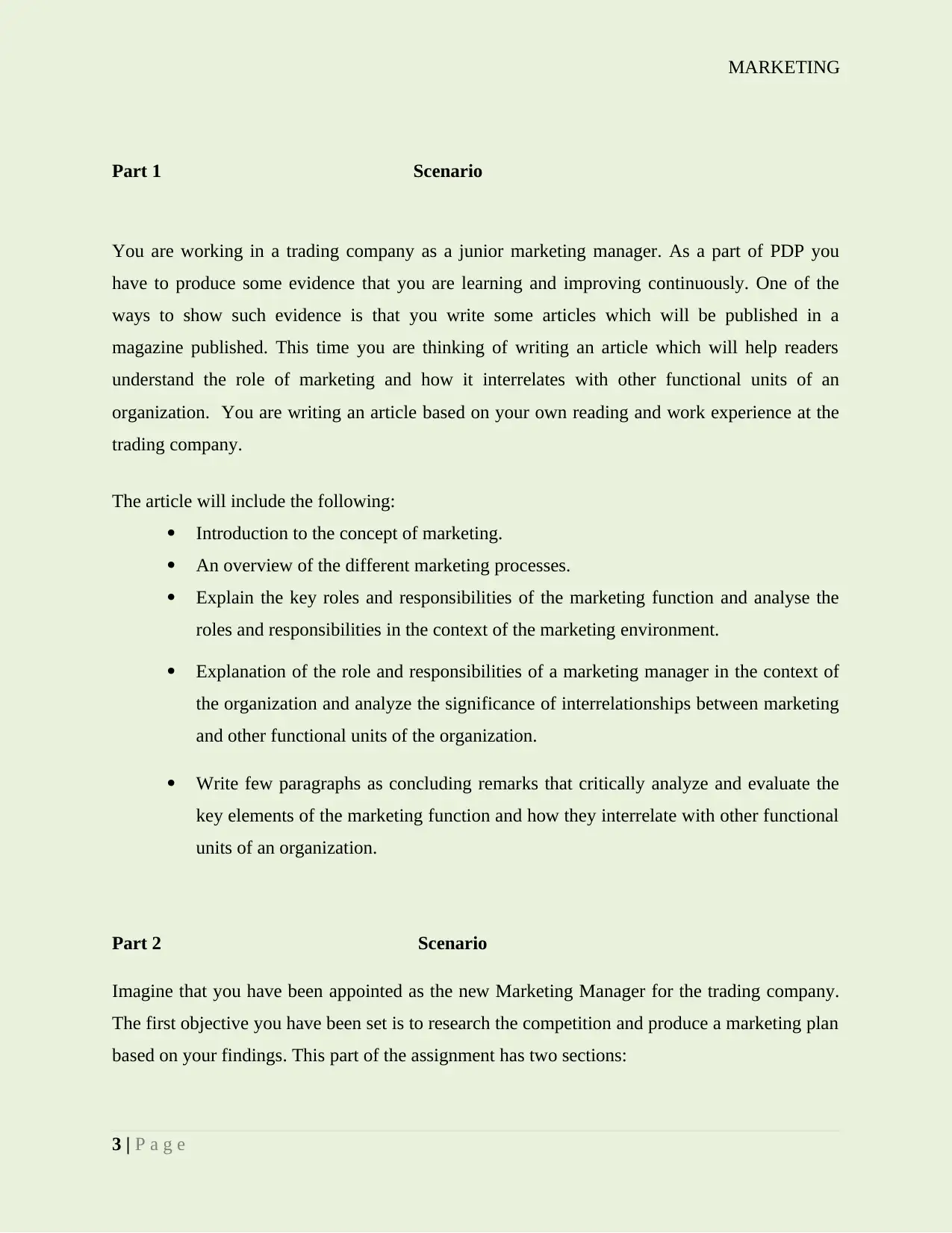
MARKETING
Part 1 Scenario
You are working in a trading company as a junior marketing manager. As a part of PDP you
have to produce some evidence that you are learning and improving continuously. One of the
ways to show such evidence is that you write some articles which will be published in a
magazine published. This time you are thinking of writing an article which will help readers
understand the role of marketing and how it interrelates with other functional units of an
organization. You are writing an article based on your own reading and work experience at the
trading company.
The article will include the following:
Introduction to the concept of marketing.
An overview of the different marketing processes.
Explain the key roles and responsibilities of the marketing function and analyse the
roles and responsibilities in the context of the marketing environment.
Explanation of the role and responsibilities of a marketing manager in the context of
the organization and analyze the significance of interrelationships between marketing
and other functional units of the organization.
Write few paragraphs as concluding remarks that critically analyze and evaluate the
key elements of the marketing function and how they interrelate with other functional
units of an organization.
Part 2 Scenario
Imagine that you have been appointed as the new Marketing Manager for the trading company.
The first objective you have been set is to research the competition and produce a marketing plan
based on your findings. This part of the assignment has two sections:
3 | P a g e
Part 1 Scenario
You are working in a trading company as a junior marketing manager. As a part of PDP you
have to produce some evidence that you are learning and improving continuously. One of the
ways to show such evidence is that you write some articles which will be published in a
magazine published. This time you are thinking of writing an article which will help readers
understand the role of marketing and how it interrelates with other functional units of an
organization. You are writing an article based on your own reading and work experience at the
trading company.
The article will include the following:
Introduction to the concept of marketing.
An overview of the different marketing processes.
Explain the key roles and responsibilities of the marketing function and analyse the
roles and responsibilities in the context of the marketing environment.
Explanation of the role and responsibilities of a marketing manager in the context of
the organization and analyze the significance of interrelationships between marketing
and other functional units of the organization.
Write few paragraphs as concluding remarks that critically analyze and evaluate the
key elements of the marketing function and how they interrelate with other functional
units of an organization.
Part 2 Scenario
Imagine that you have been appointed as the new Marketing Manager for the trading company.
The first objective you have been set is to research the competition and produce a marketing plan
based on your findings. This part of the assignment has two sections:
3 | P a g e
⊘ This is a preview!⊘
Do you want full access?
Subscribe today to unlock all pages.

Trusted by 1+ million students worldwide

MARKETING
Section A:
Based on your research, compare how [Organization A] and [Organization B] use the various
elements of the 7Ps marketing mix. This will be submitted as a briefing paper for the marketing
team.
The briefing paper will explain how the marketing mix and marketing process is used to achieve
business objectives, relating to the two chosen organisations. This research will inform your
situational analysis and enable you to formulate marketing goals and objectives for your
organisation based on the comparative findings. This will also evaluate different tactics applied
by organisations to demonstrate how business objectives can be achieved.
Section B:
Produce a marketing plan to meet marketing goals and objectives. The marketing plan should
include all elements of the 7Ps marketing mix, with an action plan and measures for monitoring
and evaluating progress and meeting of goals and objectives.
4 | P a g e
Section A:
Based on your research, compare how [Organization A] and [Organization B] use the various
elements of the 7Ps marketing mix. This will be submitted as a briefing paper for the marketing
team.
The briefing paper will explain how the marketing mix and marketing process is used to achieve
business objectives, relating to the two chosen organisations. This research will inform your
situational analysis and enable you to formulate marketing goals and objectives for your
organisation based on the comparative findings. This will also evaluate different tactics applied
by organisations to demonstrate how business objectives can be achieved.
Section B:
Produce a marketing plan to meet marketing goals and objectives. The marketing plan should
include all elements of the 7Ps marketing mix, with an action plan and measures for monitoring
and evaluating progress and meeting of goals and objectives.
4 | P a g e
Paraphrase This Document
Need a fresh take? Get an instant paraphrase of this document with our AI Paraphraser
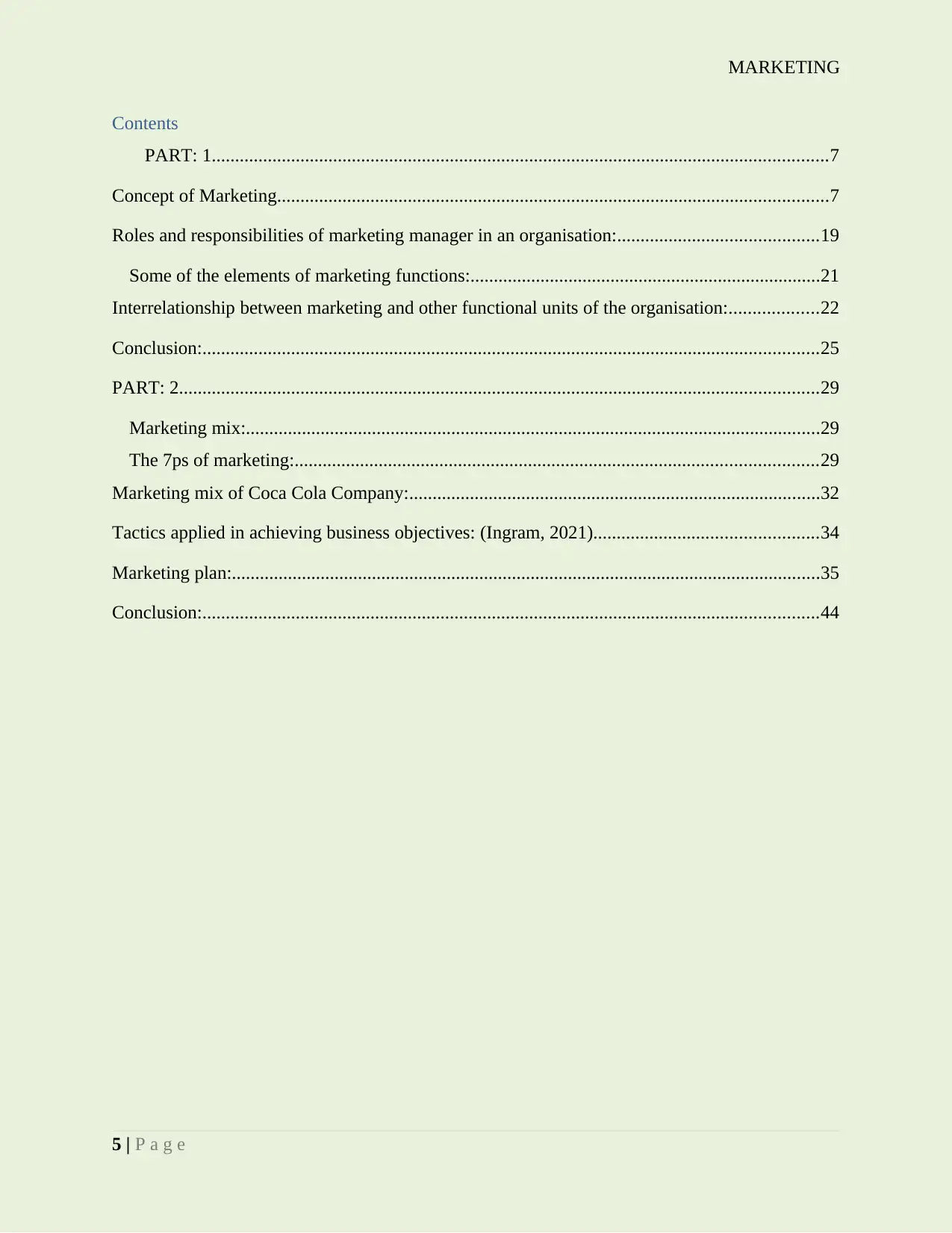
MARKETING
Contents
PART: 1....................................................................................................................................7
Concept of Marketing......................................................................................................................7
Roles and responsibilities of marketing manager in an organisation:...........................................19
Some of the elements of marketing functions:...........................................................................21
Interrelationship between marketing and other functional units of the organisation:...................22
Conclusion:....................................................................................................................................25
PART: 2.........................................................................................................................................29
Marketing mix:...........................................................................................................................29
The 7ps of marketing:................................................................................................................29
Marketing mix of Coca Cola Company:........................................................................................32
Tactics applied in achieving business objectives: (Ingram, 2021)................................................34
Marketing plan:..............................................................................................................................35
Conclusion:....................................................................................................................................44
5 | P a g e
Contents
PART: 1....................................................................................................................................7
Concept of Marketing......................................................................................................................7
Roles and responsibilities of marketing manager in an organisation:...........................................19
Some of the elements of marketing functions:...........................................................................21
Interrelationship between marketing and other functional units of the organisation:...................22
Conclusion:....................................................................................................................................25
PART: 2.........................................................................................................................................29
Marketing mix:...........................................................................................................................29
The 7ps of marketing:................................................................................................................29
Marketing mix of Coca Cola Company:........................................................................................32
Tactics applied in achieving business objectives: (Ingram, 2021)................................................34
Marketing plan:..............................................................................................................................35
Conclusion:....................................................................................................................................44
5 | P a g e
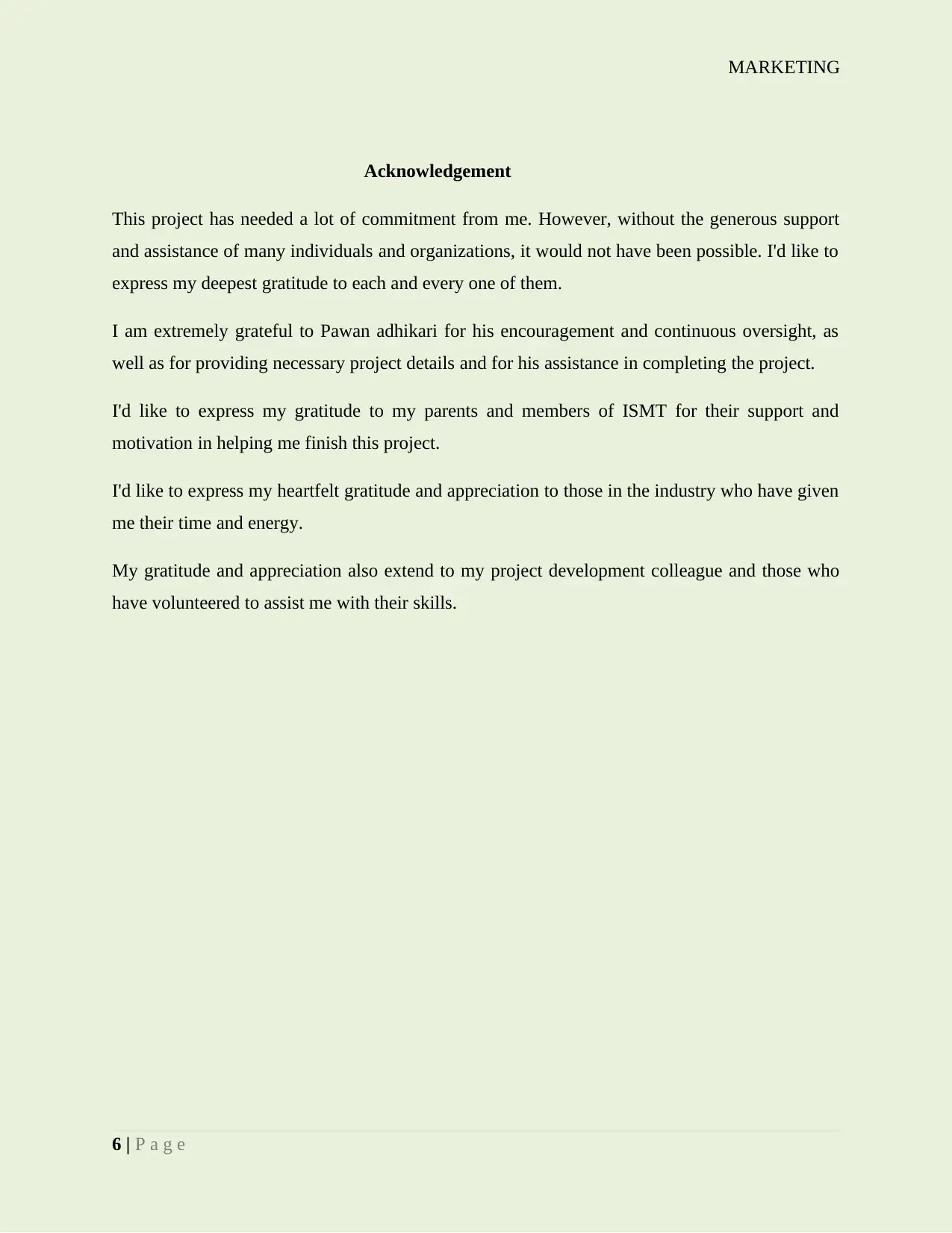
MARKETING
Acknowledgement
This project has needed a lot of commitment from me. However, without the generous support
and assistance of many individuals and organizations, it would not have been possible. I'd like to
express my deepest gratitude to each and every one of them.
I am extremely grateful to Pawan adhikari for his encouragement and continuous oversight, as
well as for providing necessary project details and for his assistance in completing the project.
I'd like to express my gratitude to my parents and members of ISMT for their support and
motivation in helping me finish this project.
I'd like to express my heartfelt gratitude and appreciation to those in the industry who have given
me their time and energy.
My gratitude and appreciation also extend to my project development colleague and those who
have volunteered to assist me with their skills.
6 | P a g e
Acknowledgement
This project has needed a lot of commitment from me. However, without the generous support
and assistance of many individuals and organizations, it would not have been possible. I'd like to
express my deepest gratitude to each and every one of them.
I am extremely grateful to Pawan adhikari for his encouragement and continuous oversight, as
well as for providing necessary project details and for his assistance in completing the project.
I'd like to express my gratitude to my parents and members of ISMT for their support and
motivation in helping me finish this project.
I'd like to express my heartfelt gratitude and appreciation to those in the industry who have given
me their time and energy.
My gratitude and appreciation also extend to my project development colleague and those who
have volunteered to assist me with their skills.
6 | P a g e
⊘ This is a preview!⊘
Do you want full access?
Subscribe today to unlock all pages.

Trusted by 1+ million students worldwide
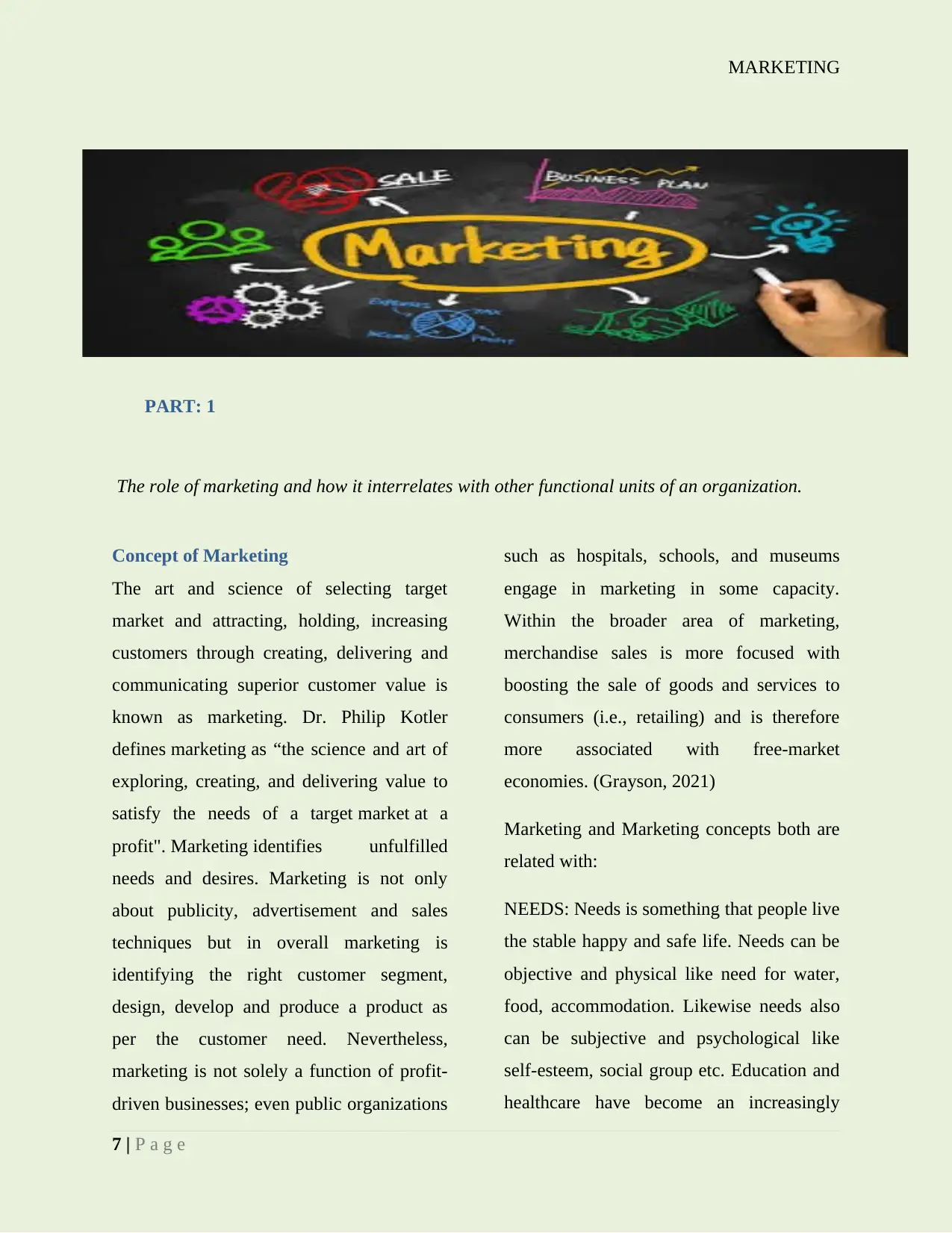
MARKETING
PART: 1
The role of marketing and how it interrelates with other functional units of an organization.
Concept of Marketing
The art and science of selecting target
market and attracting, holding, increasing
customers through creating, delivering and
communicating superior customer value is
known as marketing. Dr. Philip Kotler
defines marketing as “the science and art of
exploring, creating, and delivering value to
satisfy the needs of a target market at a
profit". Marketing identifies unfulfilled
needs and desires. Marketing is not only
about publicity, advertisement and sales
techniques but in overall marketing is
identifying the right customer segment,
design, develop and produce a product as
per the customer need. Nevertheless,
marketing is not solely a function of profit-
driven businesses; even public organizations
such as hospitals, schools, and museums
engage in marketing in some capacity.
Within the broader area of marketing,
merchandise sales is more focused with
boosting the sale of goods and services to
consumers (i.e., retailing) and is therefore
more associated with free-market
economies. (Grayson, 2021)
Marketing and Marketing concepts both are
related with:
NEEDS: Needs is something that people live
the stable happy and safe life. Needs can be
objective and physical like need for water,
food, accommodation. Likewise needs also
can be subjective and psychological like
self-esteem, social group etc. Education and
healthcare have become an increasingly
7 | P a g e
PART: 1
The role of marketing and how it interrelates with other functional units of an organization.
Concept of Marketing
The art and science of selecting target
market and attracting, holding, increasing
customers through creating, delivering and
communicating superior customer value is
known as marketing. Dr. Philip Kotler
defines marketing as “the science and art of
exploring, creating, and delivering value to
satisfy the needs of a target market at a
profit". Marketing identifies unfulfilled
needs and desires. Marketing is not only
about publicity, advertisement and sales
techniques but in overall marketing is
identifying the right customer segment,
design, develop and produce a product as
per the customer need. Nevertheless,
marketing is not solely a function of profit-
driven businesses; even public organizations
such as hospitals, schools, and museums
engage in marketing in some capacity.
Within the broader area of marketing,
merchandise sales is more focused with
boosting the sale of goods and services to
consumers (i.e., retailing) and is therefore
more associated with free-market
economies. (Grayson, 2021)
Marketing and Marketing concepts both are
related with:
NEEDS: Needs is something that people live
the stable happy and safe life. Needs can be
objective and physical like need for water,
food, accommodation. Likewise needs also
can be subjective and psychological like
self-esteem, social group etc. Education and
healthcare have become an increasingly
7 | P a g e
Paraphrase This Document
Need a fresh take? Get an instant paraphrase of this document with our AI Paraphraser

MARKETING
important element of today's needs. In
general, things that fall under the necessities
category do not need to be pushed.
Instead, the customer purchases it on their
own. However, in today's difficult and
competitive market, so many businesses
have created the same offering to meet the
customer's needs that even the "needs
category product" must be pushed into the
customer's head.
Agriculture, Real Estate (land always
appreciates), FMCG, and other examples of
requirements category items or sectors
(Bhasin, 2021)
WANTS: Wants are simply desire or
peoples wish. This is not a basic need for
survival rather it is shaped by culture and
tradition, groups etc. Wants are one point
ahead of needs, and they are mostly
dependent on the human needs. People, for
example, require bathing. However, they all
take baths with the nicest soaps. As a result,
desires are not a necessary aspect of life.
People do not require a pleasant smelling
soap, but they will use it since it is wanted.
(Bhasin, 2021)
DEMANDS: demand refers to the
consumer’s desire and ability to purchase
the goods and services available in the
market. When a person desires something
high-end but also has the financial means to
acquire it, his desires are transformed into
demands. Desire is the fundamental
distinction between desires and demands. A
customer may want something, but he or she
may not be able to get it. (Bhasin, 2021)
Examples of demands are cruises, BMWs,
and five-star hotels.
FIVE CONCEPTS OF MARKETING:
PRODUCTION CONCEPT:
Production concept believes in favor of
availability of product and equally
affordable. It is all about mass production
and distributions or in simple producing
more and earning more. The production
concept emphasizes the company's capacity
to raise output while reducing costs.
Companies that opt to shift their product's
manufacture elsewhere are an excellent
example of this concept—lowering the cost
of production while increasing profits. The
products can typically be sold for a reduced
price with this strategy, which appeals to
many buyers; nevertheless, there is usually a
tradeoff in terms of lower quality in the
finished products. (Shaw, 2021)
ASSUMPTIONS:
8 | P a g e
important element of today's needs. In
general, things that fall under the necessities
category do not need to be pushed.
Instead, the customer purchases it on their
own. However, in today's difficult and
competitive market, so many businesses
have created the same offering to meet the
customer's needs that even the "needs
category product" must be pushed into the
customer's head.
Agriculture, Real Estate (land always
appreciates), FMCG, and other examples of
requirements category items or sectors
(Bhasin, 2021)
WANTS: Wants are simply desire or
peoples wish. This is not a basic need for
survival rather it is shaped by culture and
tradition, groups etc. Wants are one point
ahead of needs, and they are mostly
dependent on the human needs. People, for
example, require bathing. However, they all
take baths with the nicest soaps. As a result,
desires are not a necessary aspect of life.
People do not require a pleasant smelling
soap, but they will use it since it is wanted.
(Bhasin, 2021)
DEMANDS: demand refers to the
consumer’s desire and ability to purchase
the goods and services available in the
market. When a person desires something
high-end but also has the financial means to
acquire it, his desires are transformed into
demands. Desire is the fundamental
distinction between desires and demands. A
customer may want something, but he or she
may not be able to get it. (Bhasin, 2021)
Examples of demands are cruises, BMWs,
and five-star hotels.
FIVE CONCEPTS OF MARKETING:
PRODUCTION CONCEPT:
Production concept believes in favor of
availability of product and equally
affordable. It is all about mass production
and distributions or in simple producing
more and earning more. The production
concept emphasizes the company's capacity
to raise output while reducing costs.
Companies that opt to shift their product's
manufacture elsewhere are an excellent
example of this concept—lowering the cost
of production while increasing profits. The
products can typically be sold for a reduced
price with this strategy, which appeals to
many buyers; nevertheless, there is usually a
tradeoff in terms of lower quality in the
finished products. (Shaw, 2021)
ASSUMPTIONS:
8 | P a g e
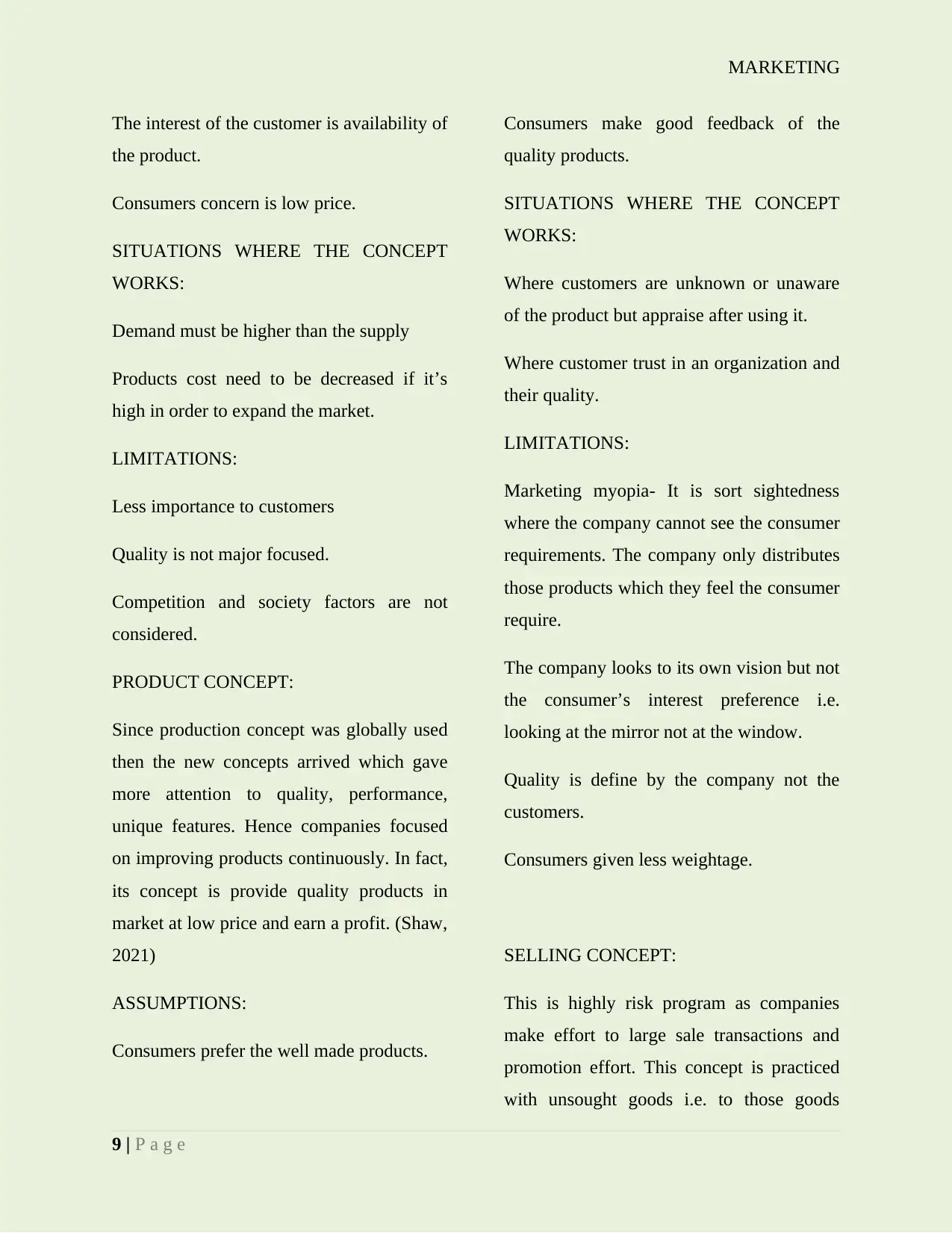
MARKETING
The interest of the customer is availability of
the product.
Consumers concern is low price.
SITUATIONS WHERE THE CONCEPT
WORKS:
Demand must be higher than the supply
Products cost need to be decreased if it’s
high in order to expand the market.
LIMITATIONS:
Less importance to customers
Quality is not major focused.
Competition and society factors are not
considered.
PRODUCT CONCEPT:
Since production concept was globally used
then the new concepts arrived which gave
more attention to quality, performance,
unique features. Hence companies focused
on improving products continuously. In fact,
its concept is provide quality products in
market at low price and earn a profit. (Shaw,
2021)
ASSUMPTIONS:
Consumers prefer the well made products.
Consumers make good feedback of the
quality products.
SITUATIONS WHERE THE CONCEPT
WORKS:
Where customers are unknown or unaware
of the product but appraise after using it.
Where customer trust in an organization and
their quality.
LIMITATIONS:
Marketing myopia- It is sort sightedness
where the company cannot see the consumer
requirements. The company only distributes
those products which they feel the consumer
require.
The company looks to its own vision but not
the consumer’s interest preference i.e.
looking at the mirror not at the window.
Quality is define by the company not the
customers.
Consumers given less weightage.
SELLING CONCEPT:
This is highly risk program as companies
make effort to large sale transactions and
promotion effort. This concept is practiced
with unsought goods i.e. to those goods
9 | P a g e
The interest of the customer is availability of
the product.
Consumers concern is low price.
SITUATIONS WHERE THE CONCEPT
WORKS:
Demand must be higher than the supply
Products cost need to be decreased if it’s
high in order to expand the market.
LIMITATIONS:
Less importance to customers
Quality is not major focused.
Competition and society factors are not
considered.
PRODUCT CONCEPT:
Since production concept was globally used
then the new concepts arrived which gave
more attention to quality, performance,
unique features. Hence companies focused
on improving products continuously. In fact,
its concept is provide quality products in
market at low price and earn a profit. (Shaw,
2021)
ASSUMPTIONS:
Consumers prefer the well made products.
Consumers make good feedback of the
quality products.
SITUATIONS WHERE THE CONCEPT
WORKS:
Where customers are unknown or unaware
of the product but appraise after using it.
Where customer trust in an organization and
their quality.
LIMITATIONS:
Marketing myopia- It is sort sightedness
where the company cannot see the consumer
requirements. The company only distributes
those products which they feel the consumer
require.
The company looks to its own vision but not
the consumer’s interest preference i.e.
looking at the mirror not at the window.
Quality is define by the company not the
customers.
Consumers given less weightage.
SELLING CONCEPT:
This is highly risk program as companies
make effort to large sale transactions and
promotion effort. This concept is practiced
with unsought goods i.e. to those goods
9 | P a g e
⊘ This is a preview!⊘
Do you want full access?
Subscribe today to unlock all pages.

Trusted by 1+ million students worldwide
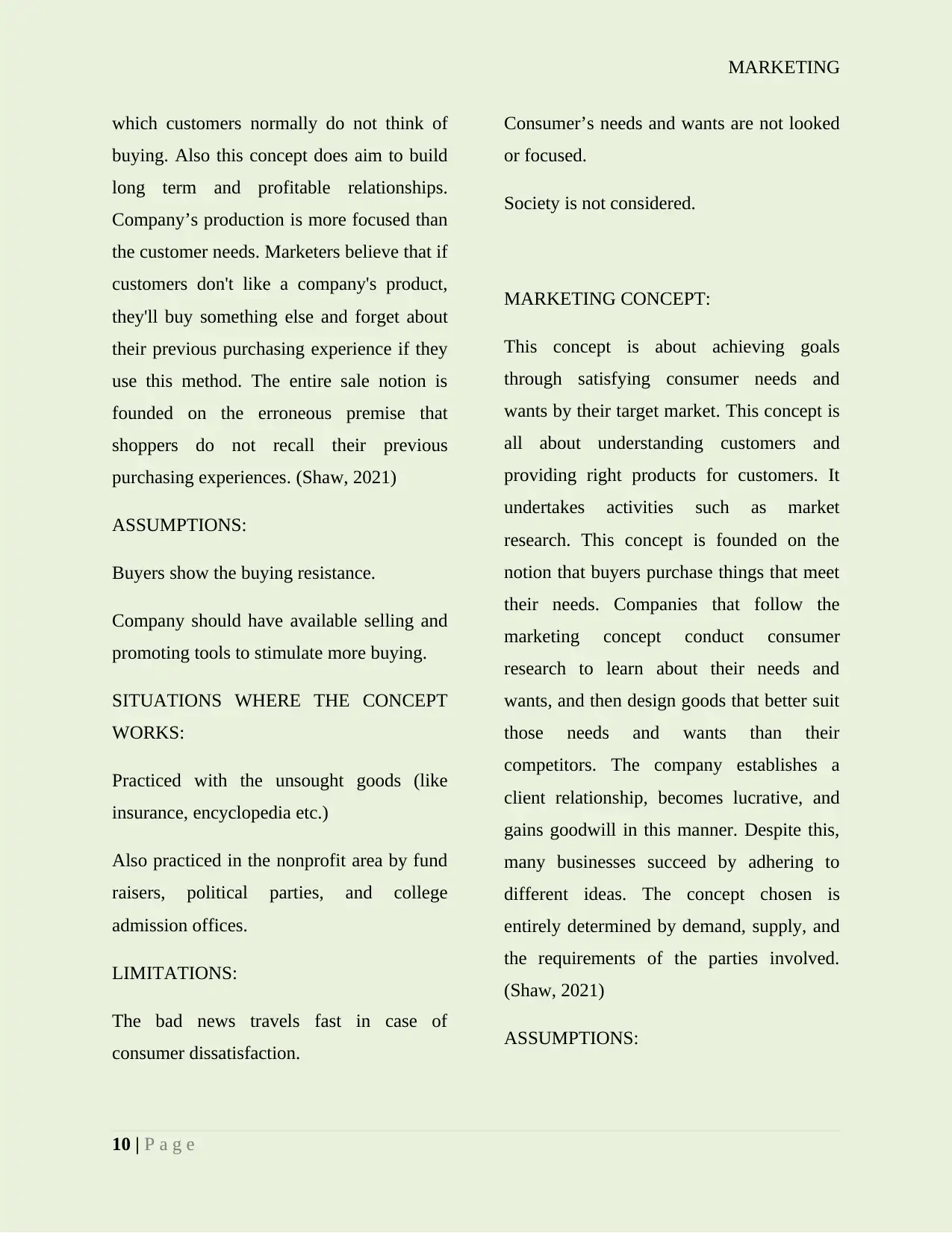
MARKETING
which customers normally do not think of
buying. Also this concept does aim to build
long term and profitable relationships.
Company’s production is more focused than
the customer needs. Marketers believe that if
customers don't like a company's product,
they'll buy something else and forget about
their previous purchasing experience if they
use this method. The entire sale notion is
founded on the erroneous premise that
shoppers do not recall their previous
purchasing experiences. (Shaw, 2021)
ASSUMPTIONS:
Buyers show the buying resistance.
Company should have available selling and
promoting tools to stimulate more buying.
SITUATIONS WHERE THE CONCEPT
WORKS:
Practiced with the unsought goods (like
insurance, encyclopedia etc.)
Also practiced in the nonprofit area by fund
raisers, political parties, and college
admission offices.
LIMITATIONS:
The bad news travels fast in case of
consumer dissatisfaction.
Consumer’s needs and wants are not looked
or focused.
Society is not considered.
MARKETING CONCEPT:
This concept is about achieving goals
through satisfying consumer needs and
wants by their target market. This concept is
all about understanding customers and
providing right products for customers. It
undertakes activities such as market
research. This concept is founded on the
notion that buyers purchase things that meet
their needs. Companies that follow the
marketing concept conduct consumer
research to learn about their needs and
wants, and then design goods that better suit
those needs and wants than their
competitors. The company establishes a
client relationship, becomes lucrative, and
gains goodwill in this manner. Despite this,
many businesses succeed by adhering to
different ideas. The concept chosen is
entirely determined by demand, supply, and
the requirements of the parties involved.
(Shaw, 2021)
ASSUMPTIONS:
10 | P a g e
which customers normally do not think of
buying. Also this concept does aim to build
long term and profitable relationships.
Company’s production is more focused than
the customer needs. Marketers believe that if
customers don't like a company's product,
they'll buy something else and forget about
their previous purchasing experience if they
use this method. The entire sale notion is
founded on the erroneous premise that
shoppers do not recall their previous
purchasing experiences. (Shaw, 2021)
ASSUMPTIONS:
Buyers show the buying resistance.
Company should have available selling and
promoting tools to stimulate more buying.
SITUATIONS WHERE THE CONCEPT
WORKS:
Practiced with the unsought goods (like
insurance, encyclopedia etc.)
Also practiced in the nonprofit area by fund
raisers, political parties, and college
admission offices.
LIMITATIONS:
The bad news travels fast in case of
consumer dissatisfaction.
Consumer’s needs and wants are not looked
or focused.
Society is not considered.
MARKETING CONCEPT:
This concept is about achieving goals
through satisfying consumer needs and
wants by their target market. This concept is
all about understanding customers and
providing right products for customers. It
undertakes activities such as market
research. This concept is founded on the
notion that buyers purchase things that meet
their needs. Companies that follow the
marketing concept conduct consumer
research to learn about their needs and
wants, and then design goods that better suit
those needs and wants than their
competitors. The company establishes a
client relationship, becomes lucrative, and
gains goodwill in this manner. Despite this,
many businesses succeed by adhering to
different ideas. The concept chosen is
entirely determined by demand, supply, and
the requirements of the parties involved.
(Shaw, 2021)
ASSUMPTIONS:
10 | P a g e
Paraphrase This Document
Need a fresh take? Get an instant paraphrase of this document with our AI Paraphraser
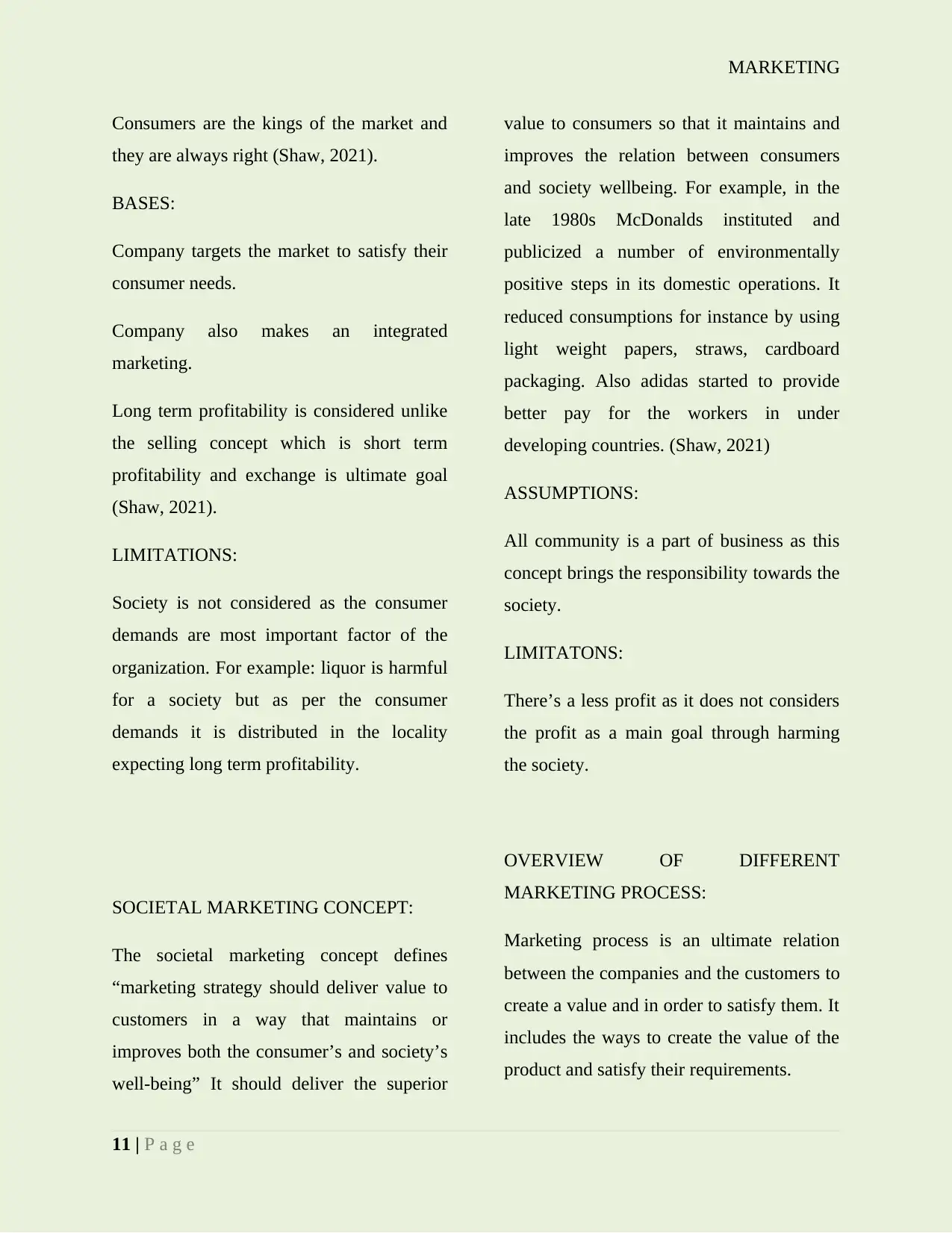
MARKETING
Consumers are the kings of the market and
they are always right (Shaw, 2021).
BASES:
Company targets the market to satisfy their
consumer needs.
Company also makes an integrated
marketing.
Long term profitability is considered unlike
the selling concept which is short term
profitability and exchange is ultimate goal
(Shaw, 2021).
LIMITATIONS:
Society is not considered as the consumer
demands are most important factor of the
organization. For example: liquor is harmful
for a society but as per the consumer
demands it is distributed in the locality
expecting long term profitability.
SOCIETAL MARKETING CONCEPT:
The societal marketing concept defines
“marketing strategy should deliver value to
customers in a way that maintains or
improves both the consumer’s and society’s
well-being” It should deliver the superior
value to consumers so that it maintains and
improves the relation between consumers
and society wellbeing. For example, in the
late 1980s McDonalds instituted and
publicized a number of environmentally
positive steps in its domestic operations. It
reduced consumptions for instance by using
light weight papers, straws, cardboard
packaging. Also adidas started to provide
better pay for the workers in under
developing countries. (Shaw, 2021)
ASSUMPTIONS:
All community is a part of business as this
concept brings the responsibility towards the
society.
LIMITATONS:
There’s a less profit as it does not considers
the profit as a main goal through harming
the society.
OVERVIEW OF DIFFERENT
MARKETING PROCESS:
Marketing process is an ultimate relation
between the companies and the customers to
create a value and in order to satisfy them. It
includes the ways to create the value of the
product and satisfy their requirements.
11 | P a g e
Consumers are the kings of the market and
they are always right (Shaw, 2021).
BASES:
Company targets the market to satisfy their
consumer needs.
Company also makes an integrated
marketing.
Long term profitability is considered unlike
the selling concept which is short term
profitability and exchange is ultimate goal
(Shaw, 2021).
LIMITATIONS:
Society is not considered as the consumer
demands are most important factor of the
organization. For example: liquor is harmful
for a society but as per the consumer
demands it is distributed in the locality
expecting long term profitability.
SOCIETAL MARKETING CONCEPT:
The societal marketing concept defines
“marketing strategy should deliver value to
customers in a way that maintains or
improves both the consumer’s and society’s
well-being” It should deliver the superior
value to consumers so that it maintains and
improves the relation between consumers
and society wellbeing. For example, in the
late 1980s McDonalds instituted and
publicized a number of environmentally
positive steps in its domestic operations. It
reduced consumptions for instance by using
light weight papers, straws, cardboard
packaging. Also adidas started to provide
better pay for the workers in under
developing countries. (Shaw, 2021)
ASSUMPTIONS:
All community is a part of business as this
concept brings the responsibility towards the
society.
LIMITATONS:
There’s a less profit as it does not considers
the profit as a main goal through harming
the society.
OVERVIEW OF DIFFERENT
MARKETING PROCESS:
Marketing process is an ultimate relation
between the companies and the customers to
create a value and in order to satisfy them. It
includes the ways to create the value of the
product and satisfy their requirements.
11 | P a g e
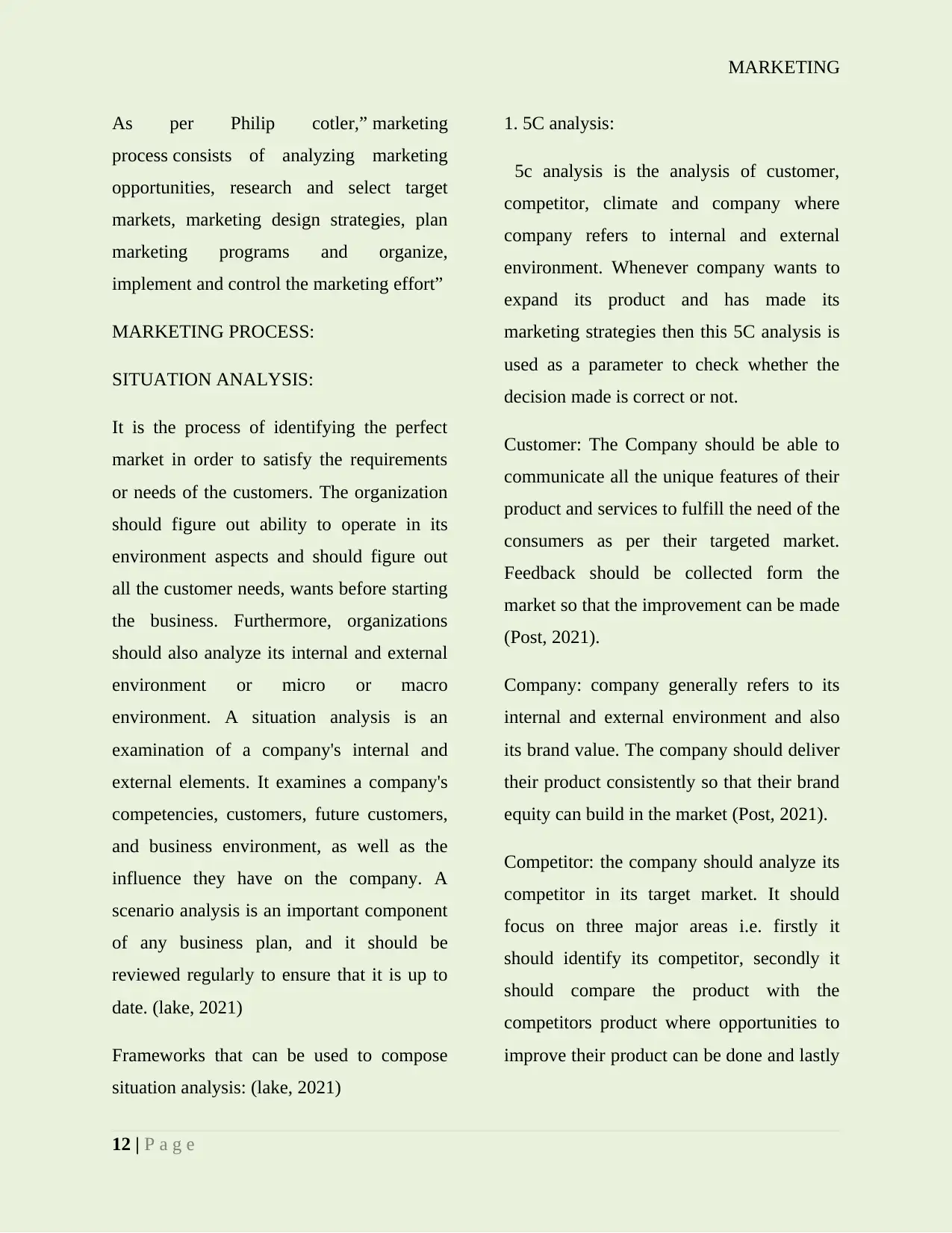
MARKETING
As per Philip cotler,” marketing
process consists of analyzing marketing
opportunities, research and select target
markets, marketing design strategies, plan
marketing programs and organize,
implement and control the marketing effort”
MARKETING PROCESS:
SITUATION ANALYSIS:
It is the process of identifying the perfect
market in order to satisfy the requirements
or needs of the customers. The organization
should figure out ability to operate in its
environment aspects and should figure out
all the customer needs, wants before starting
the business. Furthermore, organizations
should also analyze its internal and external
environment or micro or macro
environment. A situation analysis is an
examination of a company's internal and
external elements. It examines a company's
competencies, customers, future customers,
and business environment, as well as the
influence they have on the company. A
scenario analysis is an important component
of any business plan, and it should be
reviewed regularly to ensure that it is up to
date. (lake, 2021)
Frameworks that can be used to compose
situation analysis: (lake, 2021)
1. 5C analysis:
5c analysis is the analysis of customer,
competitor, climate and company where
company refers to internal and external
environment. Whenever company wants to
expand its product and has made its
marketing strategies then this 5C analysis is
used as a parameter to check whether the
decision made is correct or not.
Customer: The Company should be able to
communicate all the unique features of their
product and services to fulfill the need of the
consumers as per their targeted market.
Feedback should be collected form the
market so that the improvement can be made
(Post, 2021).
Company: company generally refers to its
internal and external environment and also
its brand value. The company should deliver
their product consistently so that their brand
equity can build in the market (Post, 2021).
Competitor: the company should analyze its
competitor in its target market. It should
focus on three major areas i.e. firstly it
should identify its competitor, secondly it
should compare the product with the
competitors product where opportunities to
improve their product can be done and lastly
12 | P a g e
As per Philip cotler,” marketing
process consists of analyzing marketing
opportunities, research and select target
markets, marketing design strategies, plan
marketing programs and organize,
implement and control the marketing effort”
MARKETING PROCESS:
SITUATION ANALYSIS:
It is the process of identifying the perfect
market in order to satisfy the requirements
or needs of the customers. The organization
should figure out ability to operate in its
environment aspects and should figure out
all the customer needs, wants before starting
the business. Furthermore, organizations
should also analyze its internal and external
environment or micro or macro
environment. A situation analysis is an
examination of a company's internal and
external elements. It examines a company's
competencies, customers, future customers,
and business environment, as well as the
influence they have on the company. A
scenario analysis is an important component
of any business plan, and it should be
reviewed regularly to ensure that it is up to
date. (lake, 2021)
Frameworks that can be used to compose
situation analysis: (lake, 2021)
1. 5C analysis:
5c analysis is the analysis of customer,
competitor, climate and company where
company refers to internal and external
environment. Whenever company wants to
expand its product and has made its
marketing strategies then this 5C analysis is
used as a parameter to check whether the
decision made is correct or not.
Customer: The Company should be able to
communicate all the unique features of their
product and services to fulfill the need of the
consumers as per their targeted market.
Feedback should be collected form the
market so that the improvement can be made
(Post, 2021).
Company: company generally refers to its
internal and external environment and also
its brand value. The company should deliver
their product consistently so that their brand
equity can build in the market (Post, 2021).
Competitor: the company should analyze its
competitor in its target market. It should
focus on three major areas i.e. firstly it
should identify its competitor, secondly it
should compare the product with the
competitors product where opportunities to
improve their product can be done and lastly
12 | P a g e
⊘ This is a preview!⊘
Do you want full access?
Subscribe today to unlock all pages.

Trusted by 1+ million students worldwide
1 out of 48
Related Documents
Your All-in-One AI-Powered Toolkit for Academic Success.
+13062052269
info@desklib.com
Available 24*7 on WhatsApp / Email
![[object Object]](/_next/static/media/star-bottom.7253800d.svg)
Unlock your academic potential
Copyright © 2020–2025 A2Z Services. All Rights Reserved. Developed and managed by ZUCOL.





